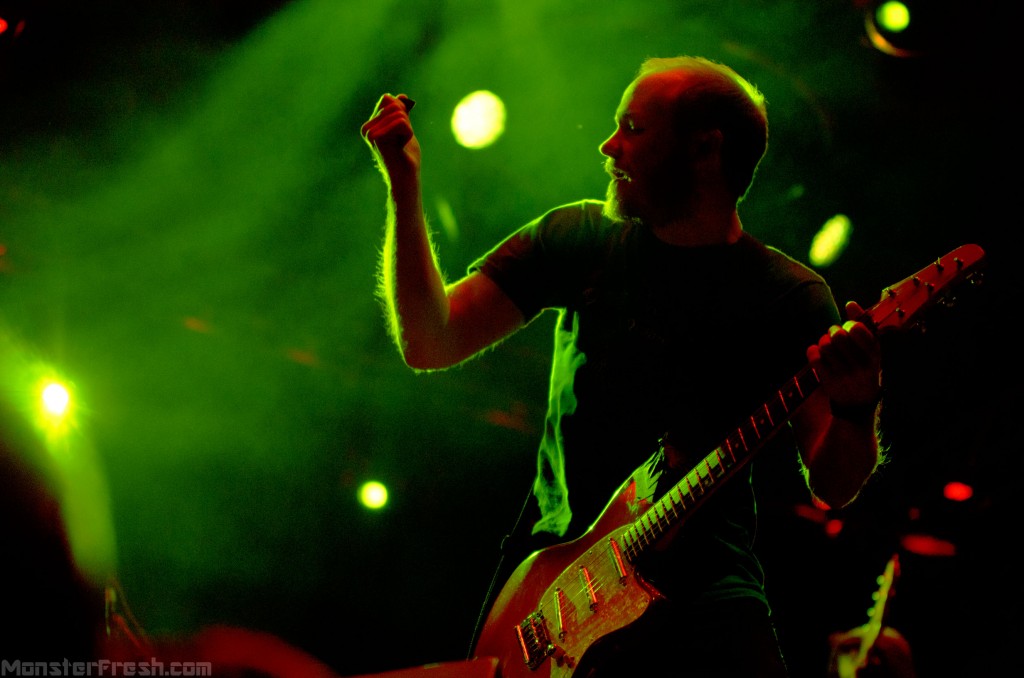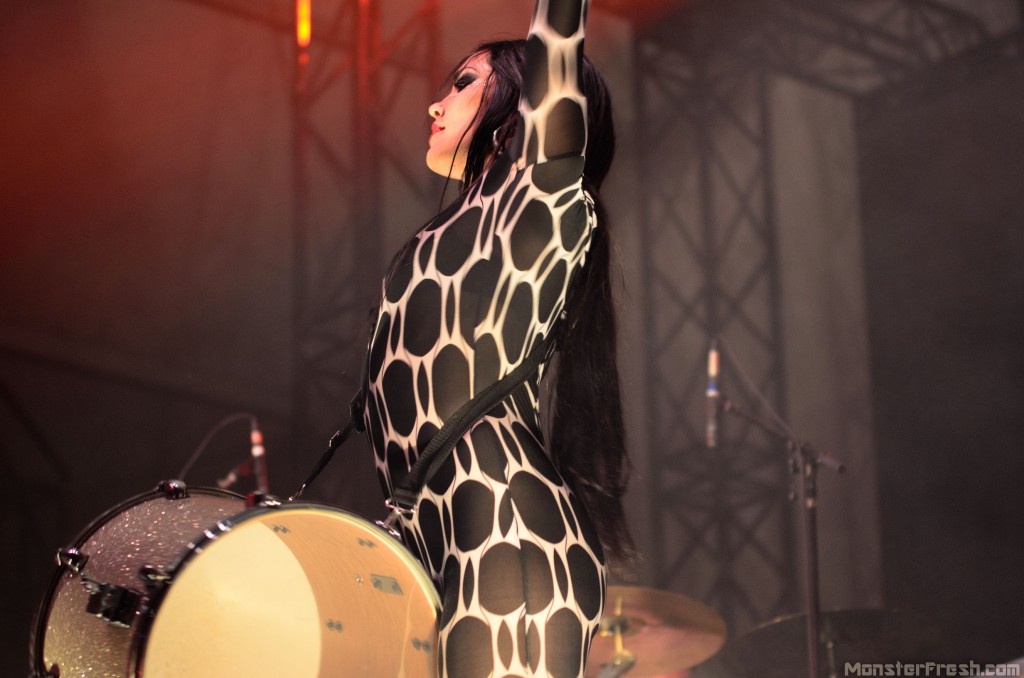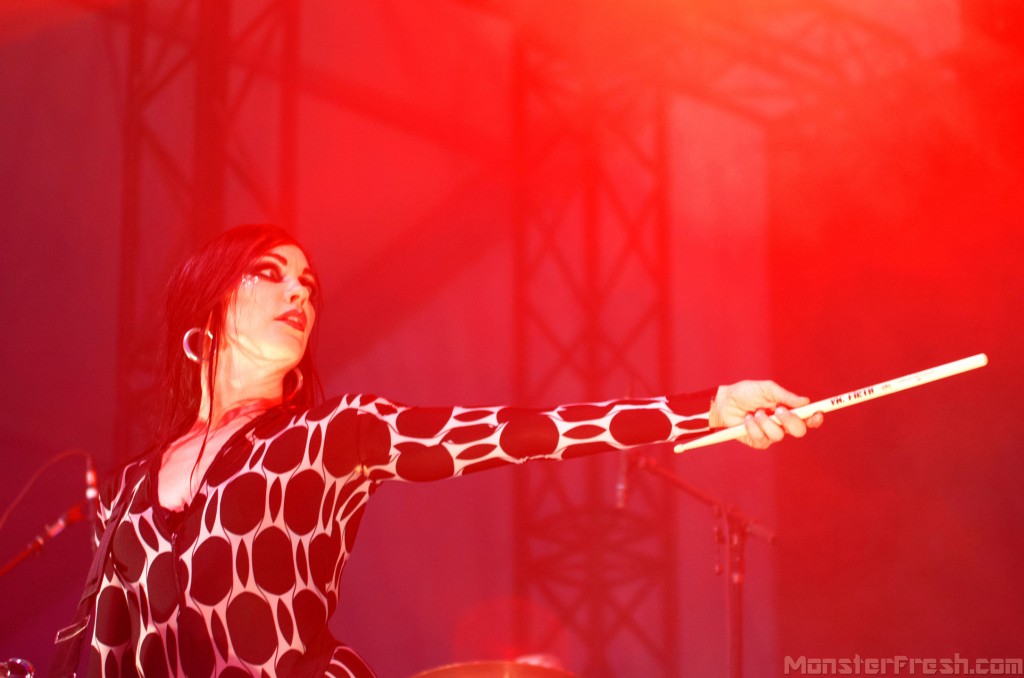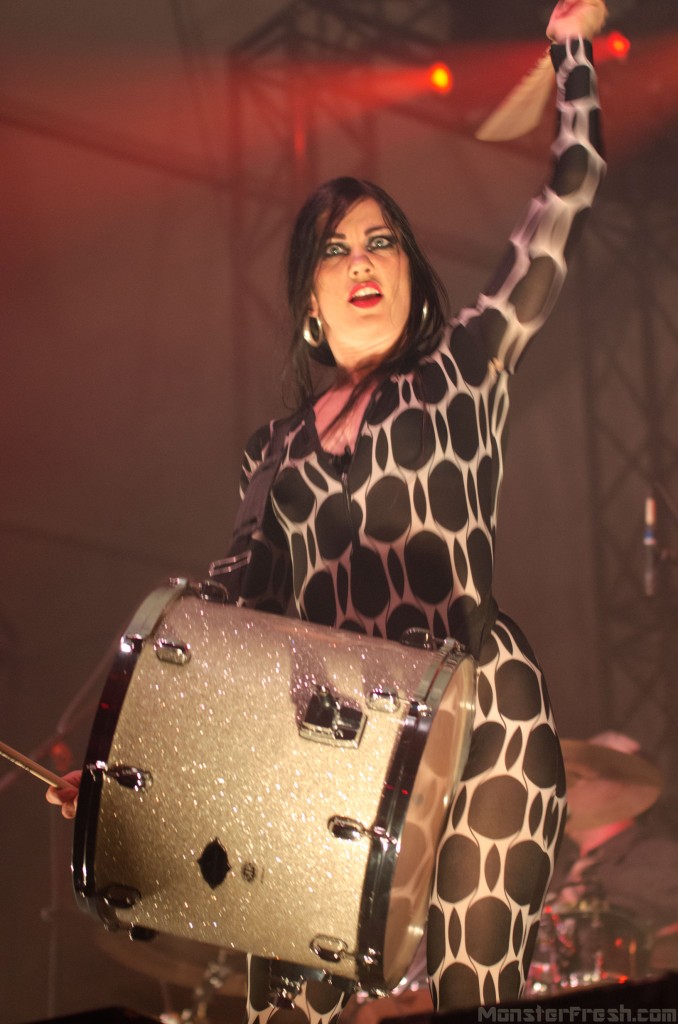DAY ONE (pt.2) : Sasquatch! Music Festival 2012 [Explosions in the Sky & Beats Antique]
some more jibba jabba. this time with reviews of Explosions in the Sky & Beats Antique with commentary on post-rock music and misguided Eastern appropriation
[CLICK HERE to read part 1]

EXPLOSIONS IN THE SKY
The Bigfoot Stage is the second largest stage at the festival. This year they upheld a fairly strict “first 3 songs” policy in the photo pit, but I somehow made it over with a little time left to shoot Texas post-rock quartet, Explosions in the Sky. Stepping past the barricade, I bumped into the first person of the weekend that I already knew. I originally met Willie after his writing ability won him the tickets from our Bill Callahan giveaway last year. Even that first encounter involved a bit of a coincidence, with his brother Aiden turning out to be an employee (albeit at a different location) of the same company that I worked for at the time. I was already having pretty good luck with finding other people so far and was really starting to feel a lot better about taking this trip solo.
As these arbitrary labels often are, the term “Post-Rock” has been met with a certain level of opposition and backlash from those feeling confined by the classification. Not unlike such influential movements as Krautrock, the canopy is broad and the styles of the bands that that have been grouped under it can differ from each other substantially. Furthermore, the original pool of artists stamped with that title aren’t typically motivated by trying to create a “movement;” they are simply trying to create unique and personal music. Providing them with restricting identifiers does little to benefit them or reflect that intention. That being said, post-rock is generally defined by it’s visceral soundscapes and the use of instruments that are typically associated with rock music being used in more unorthodox manners to create it. Electric guitars are utilized to create rich, lush layers and frail, drawn out, sweeping melodies, as opposed to being solo heavy or used for chopping out aggressive riffs. Drums and bass or used more as buoys for atmospheric sound than for heavy thumping grooves and stomps. With a few exceptions, the music is generally instrumental.
My experiences with and references to this particular categorization of music are somewhat limited. I’ve listened to plenty of Slint‘s Spiderland (credited as one of the first “post-rock” albums ever, laying the groundwork for the entire movement), but any real extensive history with or draw to the genre that I have has come primarily through the work of Tortoise, a band with a sound that is distinctly it’s own. With the incorporation of vibraphones and technical–often dual–drum segments, Tortoise‘s sound not only rests on their incredible musicianship, but it’s something that translates into awe-inspiring live performances. A Tortoise show feels like you’ve just stumbled into the middle of a practice space right as the individual members’ inspirations begin to calcify with each other and lock-in to manifest something greater as a unit. The band is always present and that intensity emanates as something truly powerful in concert, but what about the more minimal groups in the genre? How well do their atmospheric tunes lend themselves to live performances?

In May of last year, I had caught a performance by Scotland‘s Mogwai at the Showbox in Seattle and was bored to tears. In much the same way that I can hear hints of Mogwai‘s aural landscapes in Explosions, it’s easy to hear more Tortoise-esque drumming in Mogwai‘s work. The problem with Mogwai, however, was that, while the members of Tortoise interact, weave through, and play off of one-another’s contributions–often facing two drum kits towards each other and sharing vibraphone space– the Scotsman seemed to be simply going through the motions when I saw them, and the drums weren’t nearly as dynamic. Even the long-time Mogwai fans that I knew were disappointed with that performance, but explained that their regular drummer was replaced that night, due to an illness or something.
This actually wasn’t the first time that I had seen Explosions in the Sky either; a month after I’d seen Mogwai, they played the Capitol Hill Block Party. The major problem with the block party is that the stage sits at one end of a long street and, with the increasingly larger crowds occupying an area that’s flat with little width and that wasn’t designed as a venue for viewing performances, we were easily forced a couple of actual “blocks” towards the back of the crowd. From where we were, we could only hear so much of what was being played and, with Kim growing my child in her belly, there was no way that we were going to push our way much closer.
Seeing Explosions in the Sky at Sasquatch!, however, revived my faith in the post-rock show live. Their rich textures and soaring guitar work is incredibly cinematic. Blankets of warm shimmering sound blended with the gorgeous backdrop of the venue and, with the sun going down, it was both the perfect setting and the ideal point in the night to catch such a performance. When they closed out the Block Party, they also did it with a setting sun and it made me wish that I could have had a better vantage point a year ago. Everything that I wish that I could get from one of these shows, but had somehow just missed out on, was present for this set. The effect of Texas 4-piece‘s swirling wind-like orchestrations on the night was not unlike the incredible Sigur Rós tour documentary, Heima in the way that their music reflected the beautiful Icelandic landscape, as both the visual elements and the audio managed to provide a certain level of narration for one another. At the end of a long frantic day, this is this type of show that is ideal at a festival like this. It’s both rejuvenating and uplifting in the most organic way. After trudging through the dry Eastern Washington heat, the night begins to cool; light, brisk air whips through, and you can almost breathe the music in like oxygen.
This is where scheduling and environment really demonstrate their importance. If Explosions in the Sky were booked to play an afternoon set in another space, I’m not entirely convinced that it would have went over as well. I knew that Mogwai was on the schedule for Monday at the exact same stage. If they happened to go one at a time that didn’t hold any major conflicts with the schedule, I was thinking that I should probably give them another shot. This time, they would be outside of a packed night club and in far more majestic terrain.
BEATS ANTIQUE

On paper, Beats Antique reads like a fucking nightmare. A White dude in San Francisco named David “Satori” begins dating a belly dancer named Zoe Jakes and, along with his co-producer, Tommy Cappel, whom he originally collaborated with during a Burning Man decompression party, they decide to create a concept album that will compliment her passionate Eastern dance moves. Other descriptors that have been tossed around in conjunction with their bio are performance art, animalistic, world roots, electronica, spiritual, and provocative, not to mention that John Popper of Blues Traveler was featured on some of their work. If I knew anything about this backstory ahead of time, I would have never left Explosions in the Sky to make my way over to see them at the Banana Shack.
I decided to check out Beats Antique based on the indirect reference from two different people who’s opinions I do trust. The first is Les Claypool, who had the trio open up for him during one of his tours. The other one was friend and Monster Fresh contributor, Davis (aka: Memes), who has made mention of going to see them on his Facebook status in the past. “Well,” I thought. “They’re performing about 200 yards away from me. I might as well go see what their story is all about.”
The Banana Shack is the type of tent-covered side-stage that you’ll find at other, extremely hot, multi-stage festivals like Bonnaroo and Coachella, except that this is the only one of them at Sasquatch. This year Sasquatch also added another side- stage called “the Maine Stage” next to it that, at certain times, would conflict with the sound throughout the weekend. It gets confusing because, while the actual main stage is called the Sasquatch Stage, the Maine Stage (with an “e”) is actually the smallest out of the lot and used to host generally uninteresting local-based “talent.” [Side note: My unwillingness to champion what I feel is, for the most part, amateurish, milquetoast “conscious” rap will continue to be a major setback preventing me from ever landing a paid writing job in the Seattle area.] Then, of course, there’s the previously mentioned Bigfoot Stage and the slightly smaller Yeti Stage–all Sasquatch related titles. Not sure why they abandoned the theme, but maybe the organizers are considering the Bigfoot to be some sort of primate related beast that consumes bananas. Then again, the Banana Shack is used as a comedy tent for the first half of the day, before becoming a DJ/electronic venue at night, so it’s possible that they were just anticipating it getting really “bananas” in there.

I stepped in through a packed crowd and made my way up to the front, edging through into the photo pit. The security informed me that there was something like a 3 or 4 song limit on photography for their set, so I asked him what song we were on at that point and he put up a 5 with his right hand. Then he told me not to worry about it because he knows how hard it is to try and cover everything. I mention this to point out how noticeably and uncharacteristically great the staff was this year. That, of course, is with the exception of some cock smoker that was fucking with me during Bon Iver, but I’ll get to that on Day 3.
Zoe Jakes was standing center-stage in hoop earrings, dark smokey eyeshadow, and a skin-tight black and white bodysuit. She was like an Ursula the Sea Witch evil magic doppelganger of a young Tawny Kitaen–a bizarro version without the mutant corpse face. Apparently, the bodysuit could also pull over her entire head and she had been sporting it that way to perform a fan dance routine which I had missed. At this point of the show, she had a big-ass floor tom strapped around her torso, marching band-style, and was knocking the hell out of it with a pair of Vic Firth‘s. The other two members were wielding sticks of their own, with Cappel seated behind a full kit and Satori stationed behind a set of timbales. They were accompanied by a saxophonist. Although I was only photographing the set briefly, I also managed to witness Satori take hold of both a violin and a banjo within that time frame, in addition to the electronic samples that he was triggering. A projection screen provided visuals, but there was already plenty happening from a sonic standpoint. Regardless of how suspect this may all still sound, their saving grace is an obvious and essential one: the music. They actually sounded really good.
 I’m sure that they’re still a major draw for the fire-dancing, devil-stick juggling, granola rave, burning man set, but as an act, they actually didn’t come across as overly contrived. That, of course, is quite an accomplishment in itself, considering how many strikes are against them and how many times that I’ve seen similar concepts go terribly awry. Despite implications that their spiritually conscious, positive energy, chakra alignment vibe would veer them into glitter dusted, barefoot, new age accupressure waiting room music territory, Beats Antique put out some fairly dark sounds. These aren’t just some goons that got a hold of a pair of finger cymbals, tablas, and a sitar. It’s possible that this ceremonial hookah has a little bit of DMT mixed into the organic tobacco and sage.
I’m sure that they’re still a major draw for the fire-dancing, devil-stick juggling, granola rave, burning man set, but as an act, they actually didn’t come across as overly contrived. That, of course, is quite an accomplishment in itself, considering how many strikes are against them and how many times that I’ve seen similar concepts go terribly awry. Despite implications that their spiritually conscious, positive energy, chakra alignment vibe would veer them into glitter dusted, barefoot, new age accupressure waiting room music territory, Beats Antique put out some fairly dark sounds. These aren’t just some goons that got a hold of a pair of finger cymbals, tablas, and a sitar. It’s possible that this ceremonial hookah has a little bit of DMT mixed into the organic tobacco and sage.
It’s unfortunate that reading statements about things like Satori and Cappel as well-studied musicians/producers who have tirelessly worked to understand and encapsulate elements from a wide variety of musical styles from around the world are cringe-inducing, when those are admirable objectives to take on and should be recognized for their potential to provide interesting results. The problem is that such claims and, more so, the results are rarely anything but uninteresting, because the appropriation is so misguided. It’s as if Beats Antique is blissfully unaware of such stigmas associated with the term “World Music” and, in turn, go on to create something that’s substantially better than most of it. It’s not so much about the elements that influence them as it is that they know how to work with those elements and fuse them together, so as not to come across as a 2-dimensional Dave Matthews Band parking lot drum circle full of University sweatshirts and bindis on foreheads. “You like Bob Marley? Have you heard Legend? How about Rusted Root?” Like a less mathy version of larger more technical Eastern-influenced ensembles such as Estradasphere and Secret Chiefs 3, Beats Antique seem interested in exploring how to incorporate the Eastern sounds they love/respect, while creating something new from with them. It feels a lot more like appreciation as opposed to blind, appropriation, which is always the biggest fear from something like this. Their incorporation of electronics is another thing that could become a dangerous misstep, but is done tastefully enough to actually become an asset, injecting in the sort of delicately brooding and ominous environments conjured up on DJ Krush‘s cinematically visceral Jaku LP.
Even the belly dancing was a huge hit, evidenced by the fact that, any time that their name came up throughout the rest of the weekend, someone excitedly asked about if I’d seen the dancing segments. No, I hadn’t. I got there late and then I didn’t hang around too long before going back over to catch the rest of Explosions in the Sky. The crowd was intense (“in tents”) and the energy in the Banana Shack was gelling well with the performance, but I realized that I personally needed to be somewhere else at that point in the night. I had left Explosions in the Sky because it was a set for people to wind down to, but then I realized that I had actually had a really long day–just not in the actual venue–and that’s what I needed. Plus, there was still more time to get hyped up if necessary; Pretty Lights was next.